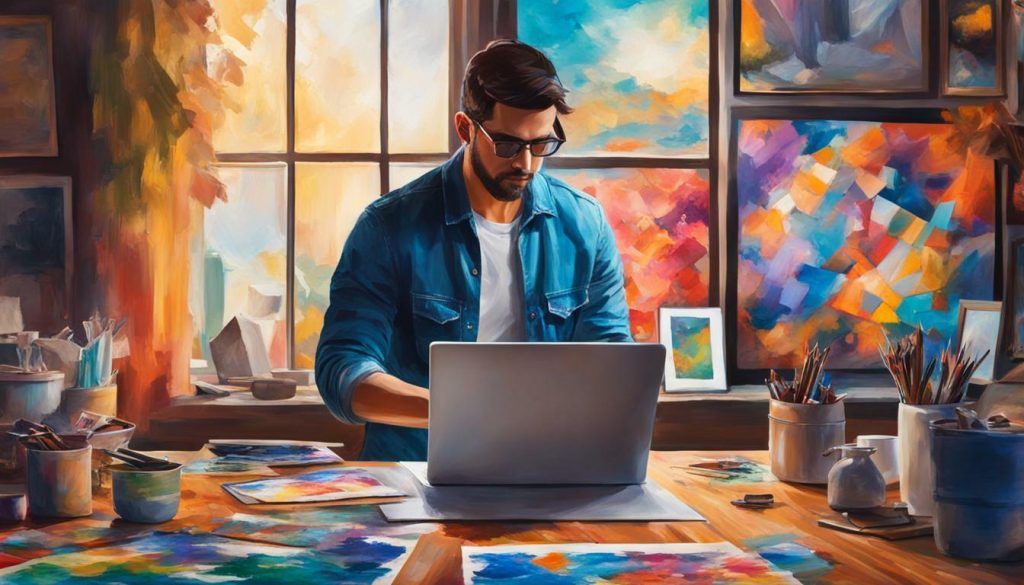Creating prints of your artwork is an excellent way to reproduce your original pieces and monetize your passion. Whether you are a professional artist or a beginner, knowing how to make prints of your art can help you expand your reach and increase your earnings. In this section, we will provide a step-by-step guide on how to make prints of your art. We will explore various art printmaking techniques and discuss the printmaking process.
First and foremost, it’s crucial to have a good understanding of the art printmaking techniques. In general, art printmaking involves transferring an image or design onto paper or canvas. Some of the popular printmaking techniques include linocut, etching, engraving, screen printing, and lithography. Each technique has its advantages and disadvantages, so it’s essential to choose the one that best suits your needs and artistic style.
Once you have selected the printmaking technique, it’s time to gather the necessary materials. The printmaking materials you’ll need will vary depending on the technique you choose, but some essential items include carving tools, ink, brayer, printing press, paper, and a clean working space. If you’re just starting, you might consider using a DIY approach to printing art at home. This option can save you money and allow you to experiment with different techniques without the need for expensive equipment.
To create prints of your artwork, you need to follow a series of steps that involve transferring the design onto the paper or canvas. The printmaking process often involves creating a plate, transferring the ink onto the plate, and pressing the plate onto the paper or canvas. By repeating this process, you can create multiple prints of your artwork.
In recent years, digital printing has become a popular option for artists looking to create high-quality prints of their artwork. Digital printing for artists involves using specialized equipment to scan and reproduce your artwork. Many professional art printing services offer digital printing, allowing you to create high-quality prints that are identical to your original artwork. When choosing a provider, it’s essential to consider factors such as pricing, quality, and turnaround time.
Finally, once you’ve created your prints, you can sell them online to reach a wider audience. With the rise of online platforms, artists now have the opportunity to print and sell their art online. It’s important to create an attractive online portfolio that showcases your artwork and provides potential buyers with all the necessary information.
In conclusion, making prints of your art requires a good understanding of art printmaking techniques and the printmaking process. By following the steps outlined in this guide, you can create high-quality prints of your artwork and increase your reach as an artist.
Key Takeaways
- Art printmaking involves transferring an image or design onto paper or canvas using various techniques.
- Essential printmaking materials include carving tools, ink, brayer, printing press, paper, and a clean working space.
- The printmaking process involves creating a plate, transferring the ink onto the plate, and pressing the plate onto the paper or canvas.
- Digital printing for artists is a popular option that involves using specialized equipment to scan and reproduce your artwork.
- You can sell your prints online by creating an attractive online portfolio that showcases your artwork.
Gathering the Necessary Materials
Before you can begin making prints of your art, you need to gather the necessary printmaking materials. Here’s a list of the essentials:
| Material | Details |
|---|---|
| Ink | You’ll need printmaking ink that’s suitable for your printing method. You can choose from oil-based, water-based, or acrylic ink. |
| Printing Press | If you’re using a traditional printmaking method like etching or relief printing, you’ll need a printing press. However, for techniques like linocut or woodcut, you can use a wooden spoon or a baren to hand-print your design. |
| Printing Plate | For intaglio techniques like etching or aquatint, you’ll need a metal plate. For relief printing techniques, you’ll make your design on a linoleum block or a piece of wood. |
| Brayer | A brayer is a roller used for applying ink to your printing plate. Choose a brayer that’s appropriate for the size of your printmaking medium. |
| Paper | You’ll need printmaking paper that’s suitable for your printing method. Choose paper that’s acid-free and has a weight of at least 250 gsm. |
| Carving Tools | If you’re using a relief printing technique, you’ll need carving tools to create your design on the printing plate. Choose a set of carving tools that are sharp and suitable for the size and complexity of your design. |
If you plan to print art at home, you can opt for a DIY approach. You can use a makeshift printing press with a rolling pin or a pasta machine. You can also use a spoon or a baren to hand-print your design. The advantage of printing art at home is that you have full control over the process, and you can experiment with different techniques.
Now that you have an idea of the necessary printmaking materials, you can begin to gather them for your art printing project.
Understanding the Printmaking Process
If you want to create prints of your artwork, it’s important to understand the printmaking process. This involves several steps that need to be followed carefully to ensure high-quality reproduction of your art.
Step 1: Preparing the Plate
The first step in creating prints of your artwork is to prepare the plate. This usually involves engraving, etching, or carving the design onto a metal, wood, or linoleum surface. The plate is then inked, and the design is transferred onto paper using a printing press.
Step 2: Inking the Plate
Once the plate is prepared, it’s time to ink it. The ink is spread evenly on the plate using a roller, and excess ink is wiped off with a cloth or paper. This ensures that the ink only remains in the carved or engraved lines.
Step 3: Transferring the Design to Paper
After the plate is inked, it’s time to transfer the design to paper. This is usually done using a printing press, which applies pressure to the plate and paper, forcing the ink onto the paper.
Step 4: Repeat the Process
To create multiple prints, the process is repeated multiple times. Each print should be carefully inspected to ensure that it meets the desired quality.

Art Reproduction Methods
There are several methods to reproduce art. In addition to traditional printmaking techniques, digital printing has become increasingly popular in recent years. It involves using a digital image of your artwork and printing it onto paper or canvas using inkjet or laser technology.
Ultimately, the method you choose will depend on the type of art you create and the quality you’re looking to achieve.
Exploring Digital Printing for Artists
Digital printing has become a popular option for artists who want high-quality prints of their artwork. While creating prints of your art at home is a great DIY approach, there are several benefits to using professional art printing services. Here, we’ll explore the advantages of digital printing for artists and how to choose the right provider.

Digital printing for artists: What are the benefits?
One of the biggest advantages of digital printing is the ability to reproduce your artwork with a high degree of accuracy. With professional art printing services, you can expect vibrant colors and crisp details that stay true to your original piece. Digital printing is also a versatile option that allows you to create multiple prints of your artwork in various sizes and formats.
Another benefit of digital printing is the convenience factor. Unlike traditional printmaking techniques that may require specialized equipment and knowledge, digital printing can be done quickly and easily through an online platform or local printing shop. This makes it a great option for artists who want to focus on creating new artwork instead of spending time on the printing process.
Choosing the right provider for digital printing: What to consider?
When choosing a provider for digital printing, it’s important to do your research and compare different options. Look for a provider that offers high-quality prints and a range of customization options, such as paper type, size, and finish. You should also consider factors such as pricing, turnaround time, and shipping options.
Reading reviews and testimonials from other artists can also be helpful in finding the right provider. Ultimately, the best provider for you will depend on your individual needs and preferences.
Printing and Selling Art Online
The internet has opened up a whole new world of opportunities for artists to sell their prints online. While there are many online platforms to choose from, it’s important to create an attractive online portfolio that showcases your artwork and highlights your unique style.
When selling art online, it’s essential to provide high-quality images of your prints along with clear and detailed descriptions. Including information about the printmaking process can also help potential buyers appreciate the value of your work.
To get started, consider setting up a dedicated online store on platforms like Etsy or Shopify. These platforms make it easy to manage your inventory and process payments securely.
Another option is to partner with a professional art printing service that offers online sales. These services can handle the printing, packaging, and shipping of your prints, leaving you to focus on creating new artwork.

When choosing an online printing and sales service, look for one that offers high-quality prints on a variety of paper types and sizes. Some services also offer marketing support and can help you reach a wider audience.
Remember that building a successful online art business takes time and effort. It’s important to continually promote your work on social media and other online channels to attract new buyers and build a dedicated fan base.
By using the power of the internet, you can turn your passion for art into a profitable online business. Just be sure to stay true to your unique artistic vision and keep experimenting with new printmaking techniques and sales strategies.
Conclusion
In conclusion, making prints of your art can be a fulfilling and lucrative endeavor. By following the step-by-step guide we provided in section 1 and gathering the necessary materials outlined in section 2, you can start creating prints of your artwork at home.
It’s important to have a good understanding of the printmaking process, as discussed in section 3, and to explore different art reproduction methods to find the one that works best for you.
If you’re looking for high-quality prints or want to explore digital printing, section 4 provides insight into professional art printing services and how to choose the right provider.
Finally, section 5 explores the process of printing and selling art online. With the rise of online platforms, artists can now reach a wider audience and sell their art from the comfort of their own home.
Final Thoughts
Making prints of your art is a fantastic way to increase your reach as an artist and turn your passion into profit. We hope this guide has provided you with the information you need to get started. Remember to experiment with different printmaking techniques and always keep the creative juices flowing. Happy printing!
FAQ
Q: How do I make prints of my art?
A: To make prints of your art, you will need to follow a printmaking process. This involves creating a master image of your artwork and then using various techniques to reproduce it in multiple copies. We have provided a detailed step-by-step guide in Section 1 of this article.
Q: What materials do I need for printmaking?
A: Printmaking requires specific materials such as printing plates, ink, brayers, paper, and a printing press or other transfer method. Section 2 of this article covers the necessary materials in more detail and provides tips for printing art at home as a DIY approach.
Q: What is the printmaking process?
A: The printmaking process involves several steps, including preparing the printing plate or surface, inking it, transferring the image onto paper, and creating multiple copies. Section 3 of this article provides a comprehensive explanation of the printmaking process and explores different art reproduction methods.
Q: Should I consider digital printing for my art?
A: Digital printing can be a great option for artists who want high-quality prints of their artwork. It offers precise color reproduction and can be more cost-effective for producing larger quantities. Section 4 of this article delves into digital printing for artists and provides insights on professional art printing services and how to choose the right provider.
Q: How can I sell art online?
A: Selling art online has become increasingly popular, and it offers artists a wide range of opportunities to reach a broader audience. Section 5 of this article explores the process of printing and selling art online, including tips on creating an attractive online portfolio and reaching potential buyers.
Share this content:






